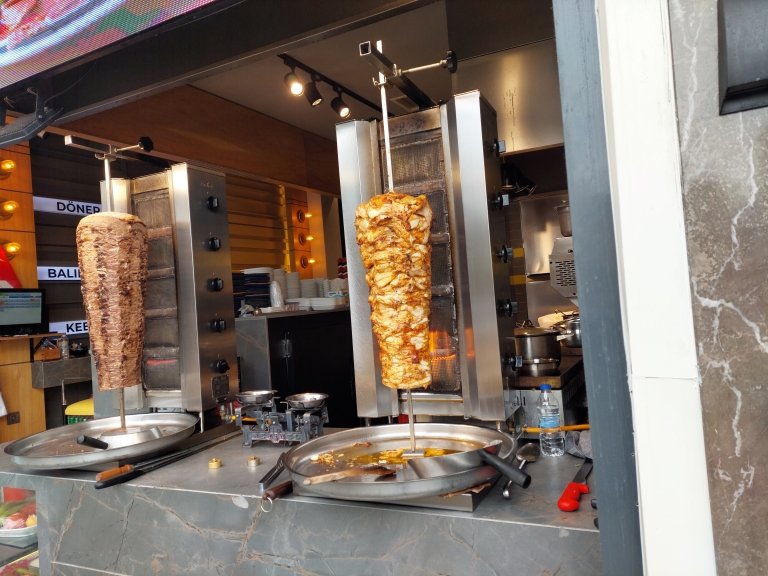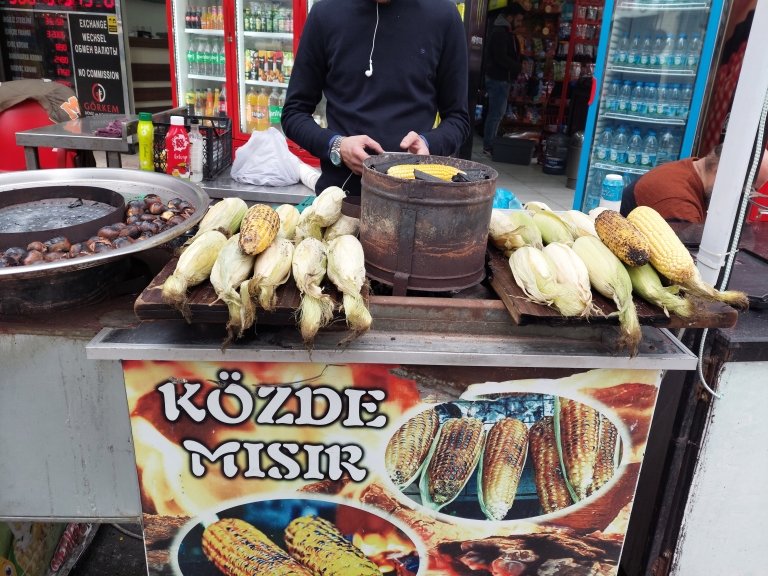Hi guys! Have you ever been to a necropolis museum? I hadn't been before. When I heard that a necropolis museum had opened in Antalya recently, I was really excited. Finding out it was a first in Turkey made me even more curious and I couldn't wait to get back to Antalya. In my previous posts, I mentioned working as a tourist guide in the past. The ancient cities we visited usually had necropolis sections and my interest in these ancient tombs started growing. For those who don't know, necropolis means city of the dead. There's a mysterious air when you say "ancient city of the dead" but it's essentially the name given to the place where the graves are collectively located. The biggest difference from modern cemeteries is that it's within the city. Nowadays cemeteries are a bit away from sight, in that sense. But that's not the only difference. There are significant variations among tomb types. From rock tombs to every kind of burial, you can find them in this city of the dead. The graves of different cultures and beliefs also varied.

Merhabalar arkadaşlar. Hiç nekropol müzesine gittiniz mi? Ben daha önce gitmemiştim. Geçenlerde Antalya'da nekropol müzesi açıldığını duyduğumda çok sevinmiştim. Sonrasında bunun Türkiye'de bir ilk olduğunu öğrendiğimde iyice merak etmeye başladım ve Antalya'ya döneceğim günü iple çekiyordum. Daha önceki yazılarımda eskiden turist rehberi olarak çalıştığımı anlatmıştım. Gittiğimiz antik şehirlerin genellikle nekropol bölümler vardı ve gide gele bu antik mezarlara olan ilgim daha da artmaya başladı. Bilmeyenler için nekropolis mezarlık demek. Eski usul ölüler şehri deyince ayrı bir gizemli havası oluyor ama nihayetinde mezarların toplu halde bulundukları yere verilen isimdir. Modern mezarlıklardan en büyük farkı şehrin içinde bulunması. Şimdiki mezarlıklar biraz gözlerden uzak ya hani o anlamda. Tabii tek farkı bu değil. Mezar tipleri arasında büyük farklar var. Kaya mezarlıklarından tutun her tür mezar bulunabilir bu ölüler şehrinde. Farklı kültürlerin ve inançların mezarları da farklılık göstermekteydi.

At the Demirciler Market - Demirciler Çarşısında
Today rain was expected, so I made all my preparations, thinking it might start pouring anytime and headed towards the Necropolis Museum. On my way I passed by the historic Demirciler Çarşısı, which translates to the Historic Blacksmiths' Bazaar. I decided to take a break and snap a few photos. It's an old bazaar in Antalya. For four generations, the shop owners here have been dealing with iron, copper craftsmanship, stoves and household items. The sign at the entrance states that the bazaar opened in 1939.
Bugün yağmur bekleniyordu ve ben yağacak diye tüm hazırlıklarımı yapıp Nekropol müzesine doğru yola koyuldum. Yolumun üstünde tarihi Demirciler çarşısı vardı. Ben de biraz mola verip birkaç fotoğraf çekmek istedim. Burası Antalya'nın eski bir çarşısı. Dededen toruna dört kuşaktır buradaki dükkan sahipleri demir, bakır işçiliği, soba, kap kacak yapıp satıyorlar. Girişteki tabelada çarşının açılış tarihinin 1939 olduğu yazıyor.
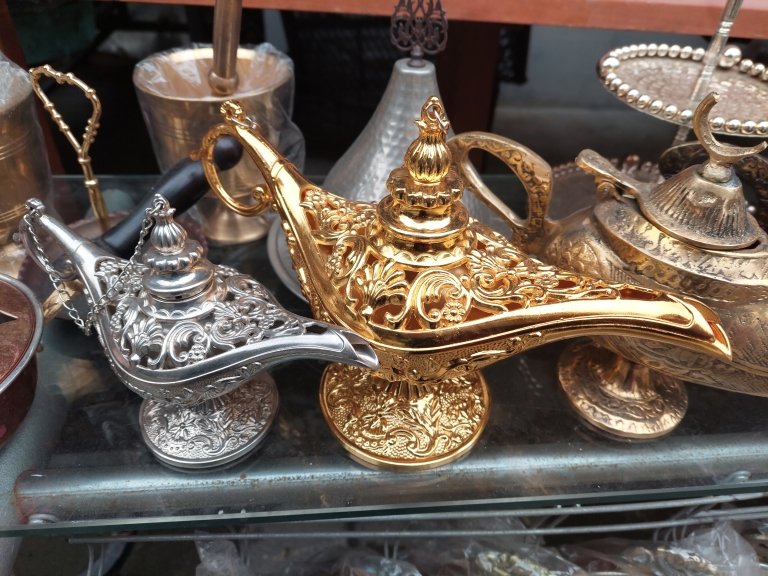
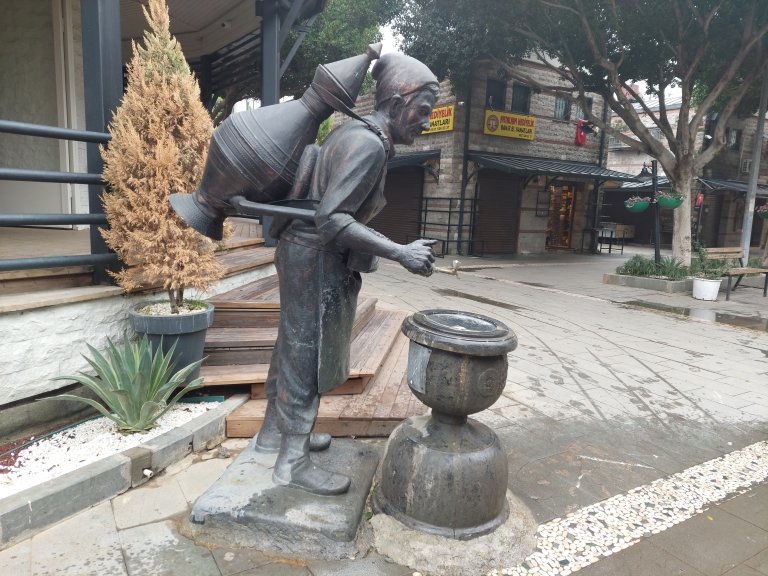
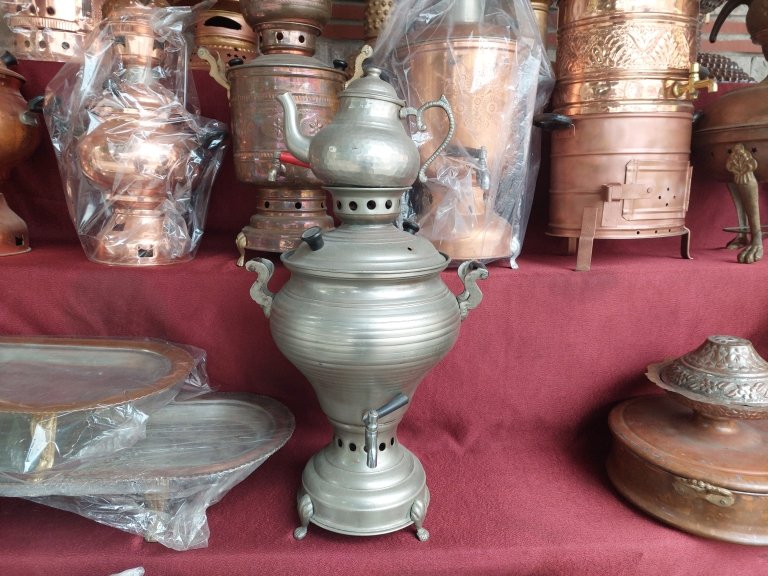





After leaving the bazaar I made my way to the museum. The weather was a bit chilly, but the rain hadn't started yet. After crossing the tramway tracks, I reached the Eastern garage. This place used to be a bus terminal, where buses from other cities would stop to pick up and drop off passengers. Probably due to traffic congestion, they later moved the terminal a bit further from the city center. They didn't change the name though. It remained as the Eastern garage. There are places like that in Antalya. For example: Dedeman Hotel changed its name to Akra. But since everyone knew that area as Dedeman the neighborhood and the bus stop's name didn't change.
Çarşıdan çıktıktan sonra müzeye doğru yöneldim. Hava biraz serindi ama yağmur başlamamıştı. Tramvay yolunu geçtikten sonra Doğu garajina ulaştım. Eskiden burası otogarmış ve başka illerden gelen otobüsler buraya uğrayıp yolcu alıp boşaltırlarmış. Sonradan muhtemelen trafik yoğunluğundan dolayı otogarı şehrin biraz daha dışına taşımışlar. Bu yerin ismini ise değiştirmemişler ve Doğu garajı olarak kalmış. Antalya'da bu tür yerler var. Örneğin Dedeman otelinin de adı değişip Akra oldu. Ama herkes o bölgeyi Dedeman olarak bildiği için semtin ve durağın adı değişmedi.


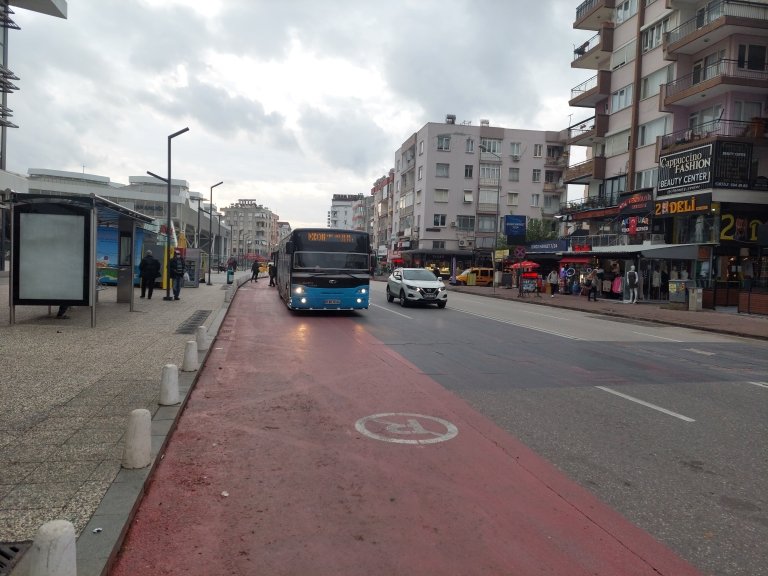

At the Necropolis Museum - Nekropol müzesinde
About ten years ago, construction for a shopping mall began in the area where the Necropolis Museum is now located. As far as I vaguely remember, there used to be a bazaar and fishermen here. Later they decided to turn it into a shopping center, and construction started. It was precisely at that time that they began discovering numerous graves as they excavated. After informing the authorities, this part of the area was protected, and archaeologists started working to unearth the buried tombs. The shopping mall was still built nearby, but it isn't a highly frequented center. Mark Antalya nearby seems to be more popular compared to this.
Nekropol müzesinin bulunduğu mevkide on yıl kadar önce AVM inşaatı başladı. Benim hayal meyal hatırladığım kadarıyla burada bir çarşı ve balıkçılar vardı. Daha sonradan buraya alış veriş merkezi yapmaya karar verdiler ve inşaat başladı. İşte tam da o sırada kazı yaptıkça burada çok sayıda mezar bulmaya başlamışlar. Yetkililere haber verildikten sonra bölgenin bu kısmı korumaya alınmış ve arkeologlar çalışma yaparak yer altındaki kayıp mezarları gün yüzüne çıkarmışlar. AVM yine de yan tarafta yapıldı. Ama çok da rağbet gören bir merkez değil. Yakındaki Mark Antalya daha bir popüler buraya göre.
The lower part of the museum houses the ancient graves. I passed through glass walkways to reach this section. Each grave was unique. There were single-person to four-person graves, single-chambered, double-chambered, with sarcophagi and many other types I couldn't count. The artifacts found in these graves, such as jewelry, household items and other belongings, are exhibited in the upper part of the museum.
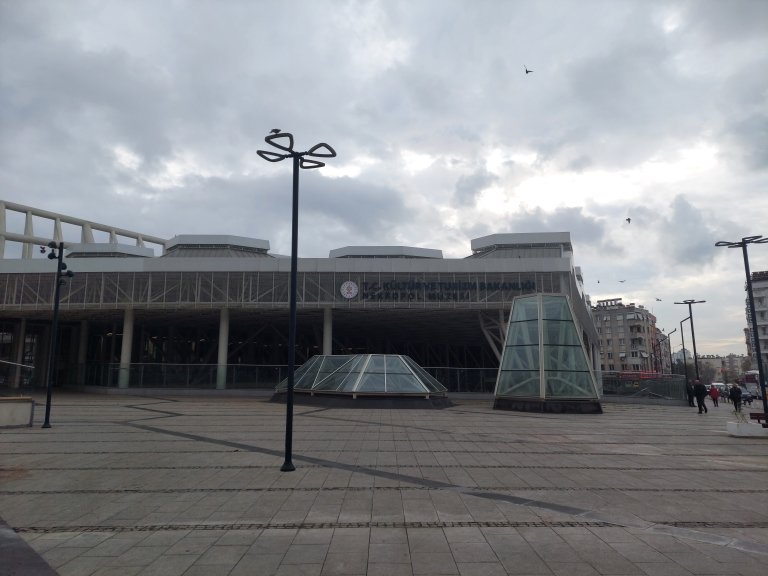
Müzenin alt kısmında eski mezarlar yer alıyor. Cam geçitlerden geçip buraya ulaştım. Mezarlar hepsi birbirinden farklıydı. Tek kişilkten 4 kişiliğe, tek odalı, çift odalı, lahitli ve daha sayamadığım çok farklı mezarlar var. Mezarlardan bulunan çok sayıda ziynet eşyası, kap kacak ve diğer eşyalar müzenin üst kısmında sergileniyor.
Since this place is relatively new, I didn't see many information boards about the graves. There was some information about the graves and the items found inside a few of them.
Burası daha çok yeni olduğundan mezarlar hakkında çok fazla bilgilendirme levhaları göremedim. Birkaç mezarın üstünde mezarla ve içinde bulunan eşyalarla ilgili bilgi yer alıyordu.


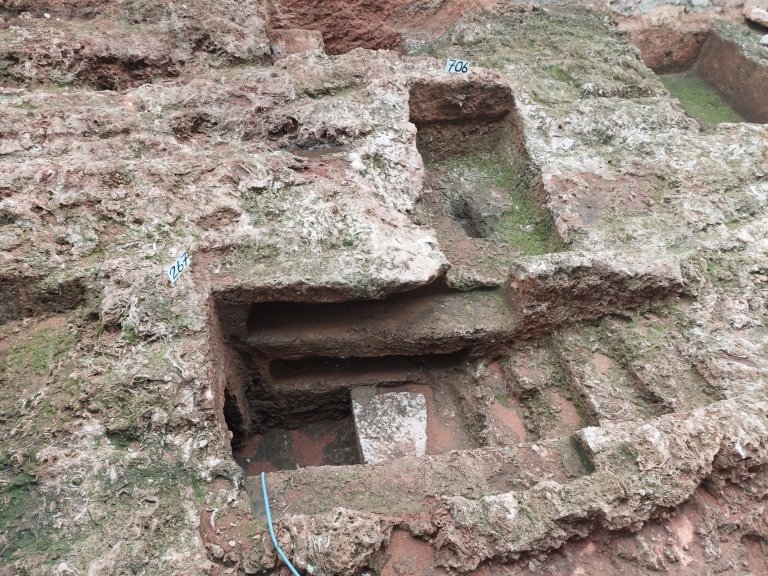

Especially intriguing were the graves with sarcophagi and sarcophagus lids. It was noted that in one of these tombs, an undisturbed skeleton was found. In other graves, they found scattered skeletons. And gifts presented to the deceased in the graves were removed and placed in the museum. Soil pots, jewelry and coins were commonly found in the graves.
Özellikle lahitli ve lahit kapaklı mezarlar ilgi çekiciydi. Bu tür mezarlardan birinde şekli bozulmamış bir iskelet bulunduğu yazıyordu. Diğer mezarlardaysa dağınık halde iskeletler bulmuşlar. Ayrıca mezardan ölülere sunulan hediyeler de çıkarılıp müzeye teslim edilmiş. Genellikle mezarlarda toprak kaplar, ziynet eşyaları ve sikkeler bulunmuş.
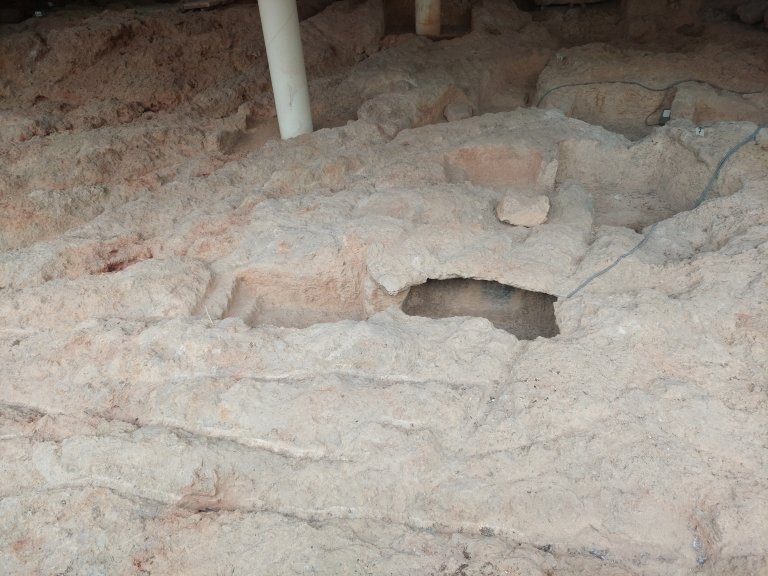


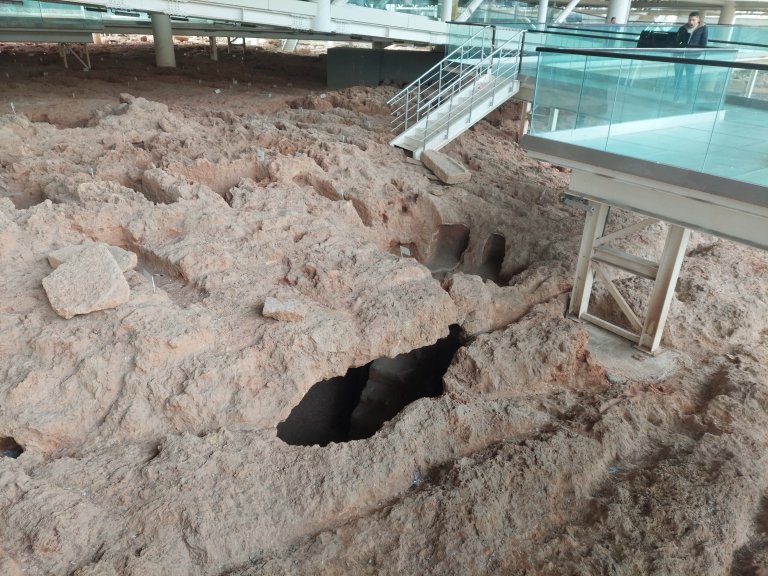
A plaque in the museum stated that there were a total of 866 graves found here. It's mentioned that this place was used between the 3rd century BC and the 5th century AD. These are significant discoveries because it was previously known that Antalya was founded by the Bergama king 2nd Attalos. The discovery of this necropolis indicates that the city existed before Attalos time.
Müzedeki bir levhada burada bulunan toplam mezar sayısının 866 olduğu yazıyor. Yıl olarak ise bu yerin M.Ö. 3. yüzyıl ile M.S. 5. yüzyıl arası kullanılmış olduğu belirtiliyor. Bunlar çok önemli buluşlar. Çünkü bu zamana kadar Antalya'nın Bergama kralı 2. Attalos tarafından kurulduğu bilinmekteydi. Bu nekropolün bulunması şehrin Attalos öncesinde de varlığını sürdürdüğü anlamına geliyor.
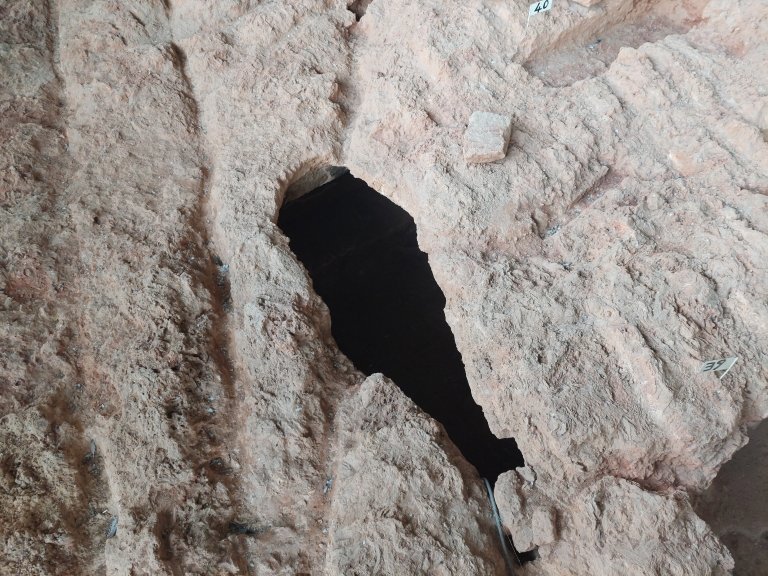
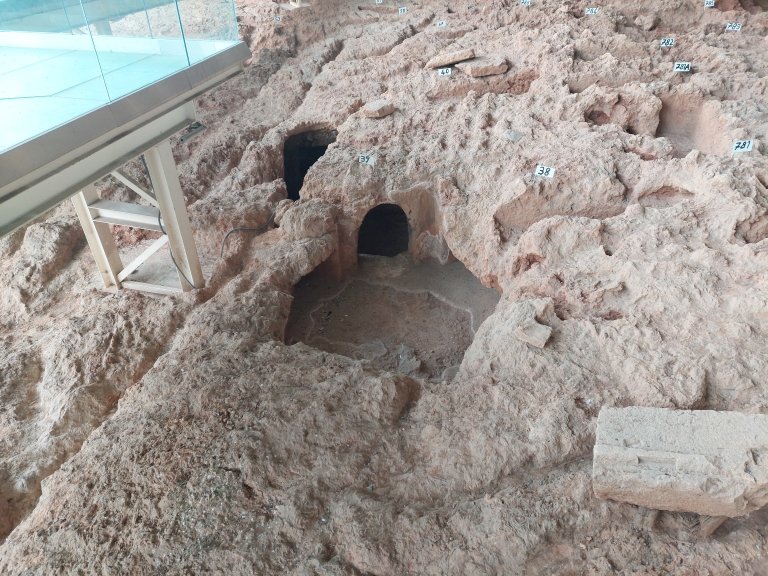

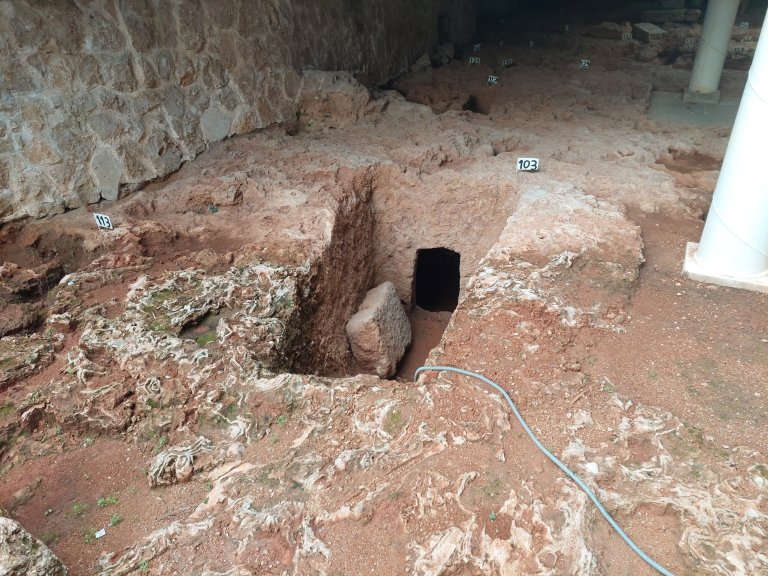
On the upper floor of the museum, there are halls exhibiting grave steles, altars, sarcophagi, and various items found in the graves. There are numerous historical artifacts from the Roman and Hellenistic periods.
Müzenin üst katında yer alan salonlarda mezar stelleri, sunaklar, altarlar, lahitler ve mezarlarda bulunan çeşitli eşyalar sergilenmekte. Roma ve Hellenistik döneme ait çok sayıda tarihi eser var.

Steles are grave stones that contain information about the deceased, sculptures, floral and wreath motifs and inscriptions.
Steller mezar taşlarıdır. Bunların üzerinde ölen kişiyle ilgili bilgiler, heykeller, çiçek ve çelenk motifleri, yazılar yer almakta.


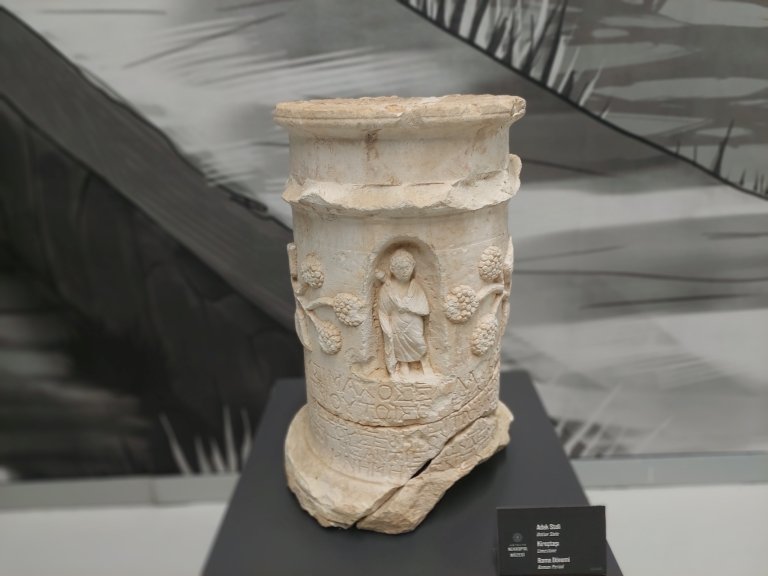


Sarcophagi are rectangular graves made of marble or stone. In the museum, there are two types exhibited: marble and limestone sarcophagi. The details on the marbles are better preserved and clearer, while the limestone sarcophagi seem to have undergone more degradation. Also as I've mentioned during my visits to other ancient cities, Medusa figures are frequently found on sarcophagus lids, serving as a kind of ancient evil eye charm.
Lahitler mermer veya taştan yapılmış dikdörtgen mezarlardır. Müzede mermer ve kireçtaşı olmak üzere iki çeşit lahit sergilenmekte. Mermerlerin üzerindeki detaylar daha güzel korunmuş ve daha netken kireçtaşı lahitlerin daha fazla bozulmaya uğradıkları dikkat çekmekte. Ayrıca diğer antik kent ziyaretlerimde bahsetmiştim, lahit kapaklarında Medusa figürüne sıkça rastlanmakta. Bir çeşit antik nazar bocuğu görevi görüyordu.
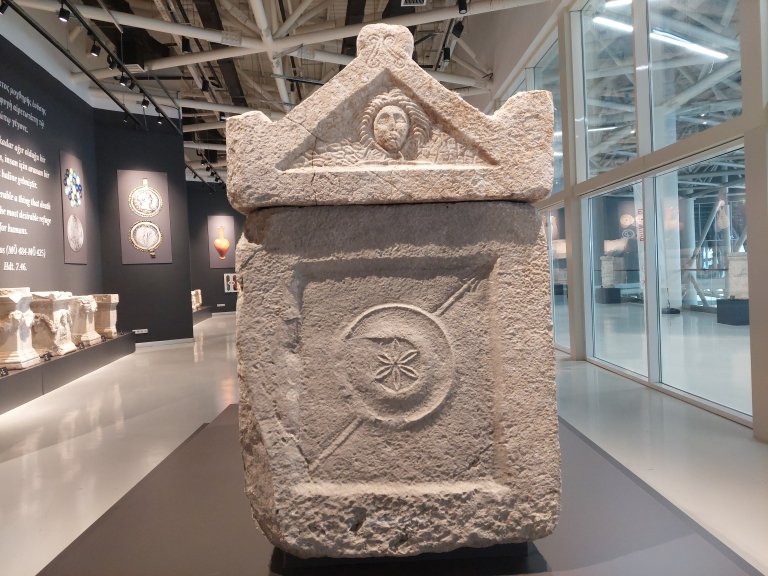
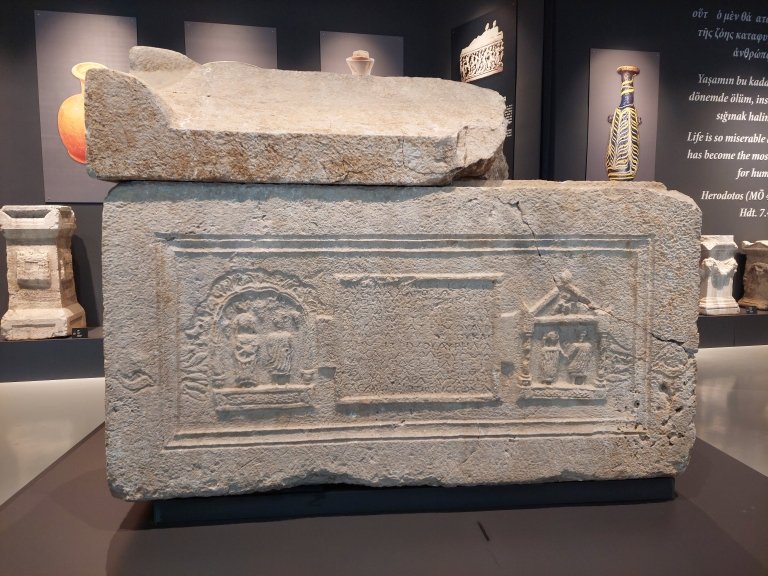

Another type of exhibit in the museum is altars. As the name suggests, these are stones used in various religious rituals and dedicated to the deceased.
Müzede sergilenen bir başka eser çeşidi sunaklar. Bunlar da adından anlaşılacağı gibi çeşitli dini ritüellerde kullanılan ve ölen kişiye adanmış taşlardır.
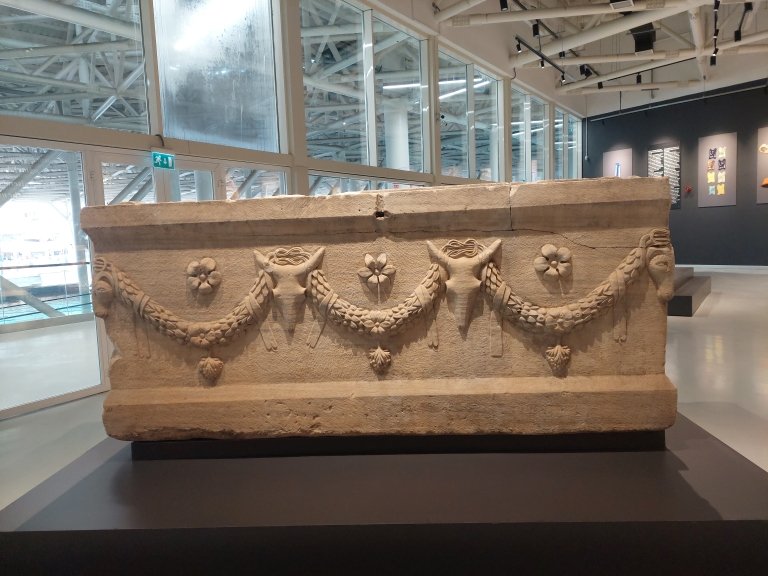
Ram-figure sarcophagi also draw attention. In ancient times, rams symbolized prosperity and could also be perceived as a kind of offering or sacrifice to honor the deceased.
Koç figürlü lahitler de dikkat çekiyor. Antik zamanlarda koçlar bereket sembolüydü ayrıca ölen kişinin anısına veya ruhuna sunulan bir tür bağış veya kurban olarak da algılanabilir.
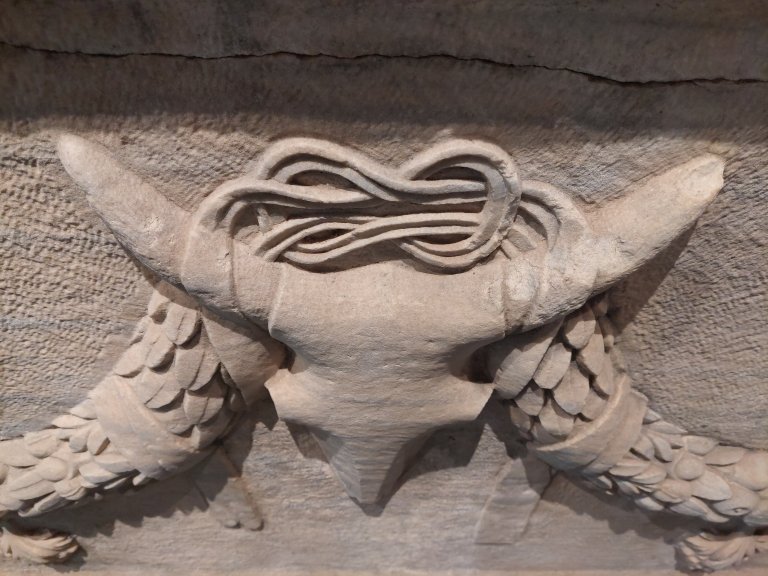
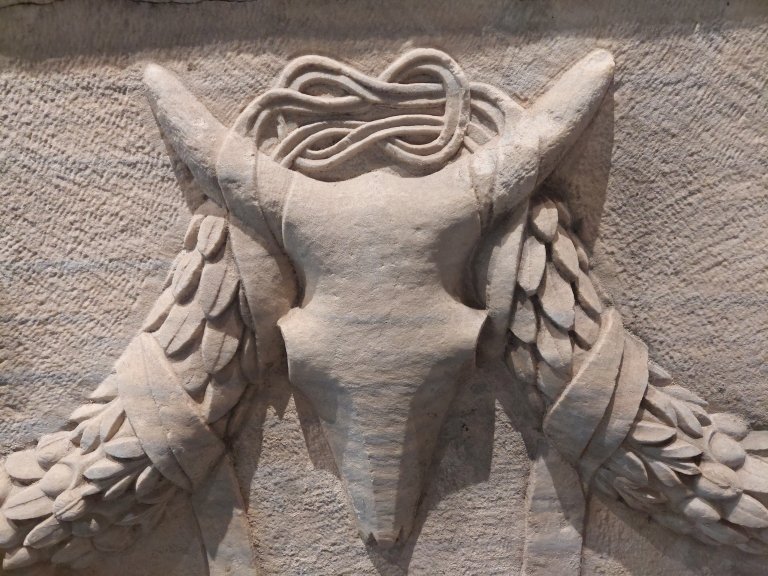
The images of fishermen transporting the souls of the deceased to the underworld were also quite impressive. Those familiar with mythology know that there's a ferryman in myths who carries the souls of the dead to the underworld and demands a fee in return. Hence coins were placed in the mouths of the dead. Without payment, the ferryman wouldn't transport anyone to the other side.
Ölülerin ruhunu öteki dünyaya taşıyan balıkçı görselleri de çok etkileyici. Mitolojiyle ilgilenenler bilirler, mitlerde ölülerin ruhlarını yeraltı tanrısına götüren bir kayıkçı var ve bunun karşılığında bir geçiş ücreti almakta. Bu yüzden ölülerin ağızlarına para sıkıştırılır. Parayı almadan kayıkçı kimseyi öteki tarafa götürmez.

In one of the halls, there's a quote from the famous philosopher Epictetus. I enjoy reading Stoics, especially finding Epictetus life struggle admirable. His ideas about finding calmness and inner strength in the face of difficulties both impress and inspire me.
Salonlardan birinde ünlü filozof Epiktetos'un bir sözü yer alıyor. Stoacıları okumayı severim, özellikle Epiktetos'un hayat mücadelesini hayranlık uyandırıcı buluyorum. Zorluklar karşısında sakinlik ve içsel güç bulma fikirleri, beni hem etkiliyor hem de kendisine hayran bırakıyor.
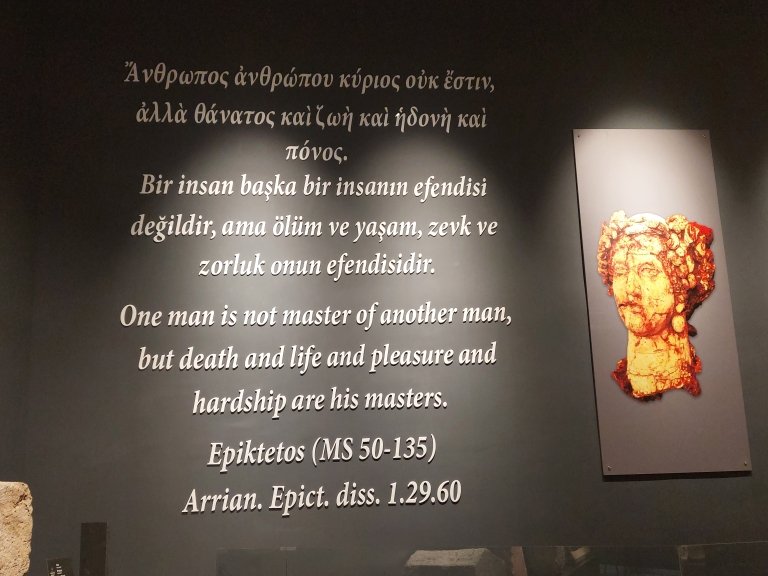
One of the halls is dedicated to inscriptions from the necropolis. The gallery provides an opportunity to delve into deep thoughts about wisdom from the past and the meaning of life.
Bir salonda nekropolisten bulunan yazıtlara yer verilmiş. Galeri geçmişten gelen bilgelik ve yaşamın anlamı hakkında derin düşüncelere dalma fırsatı sunuyor.

Bu büyük amforaların içinde de bir zamanlar ölülerin gömüldüğü bilinmekte. Daha önce Antalya müzesini gezdiğimde böyle bir amforanın içinde bulunmuş olan iskeletin fotoğrafını sizlerle paylaşmıştım. Muhtemelen bu tür kapların üreticiliğinin yoğun olduğu toplumlarda bu yola gidilmiş.
It's known that these large amphorae once contained the remains of the deceased. When I visited the Antalya museum earlier, I shared a photo of a skeleton found in such an amphora. Presumably, in societies where the production of these types of vessels was intense, this practice was common.


Ostotheks are also among the artifacts exhibited in the museum. They closely resemble sarcophagi in appearance, but their sizes are considerably smaller. After the cremation of the deceased, their ashes were stored in these types of small ostotheks. On them, wreaths made of laurel and lotus leaves, which were abundant at that time, are frequently found.
Ostotekler de müzede sergilenen eserler arasında yer almakta. Bunlar görünüş itibariyle lahitlere çok benziyorlar ama boyutları oldukça küçük. Ölülerin kremasyonu sonrasında külleri bu tür küçük ostotekler içinde saklanırmış. Üzerlerinde o zamanlar bol olan defne ve lotus yapraklarından yapılmış çelenklere sıkça rastlanmakta.
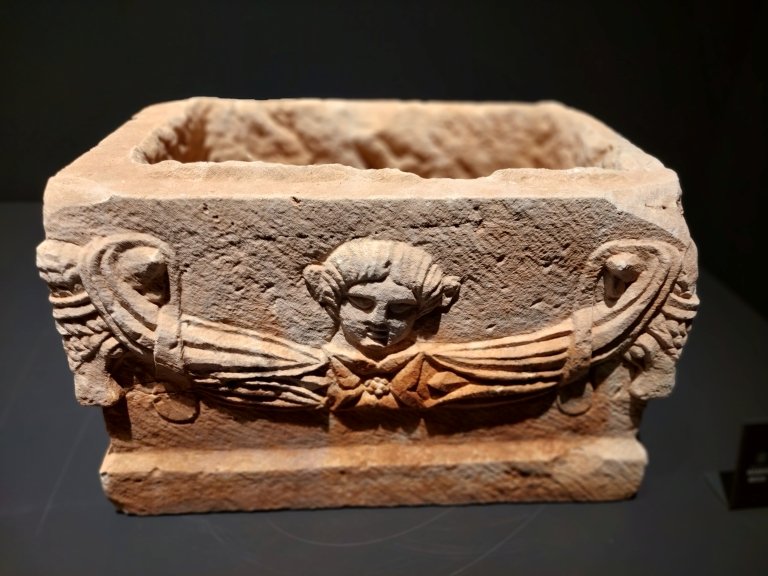
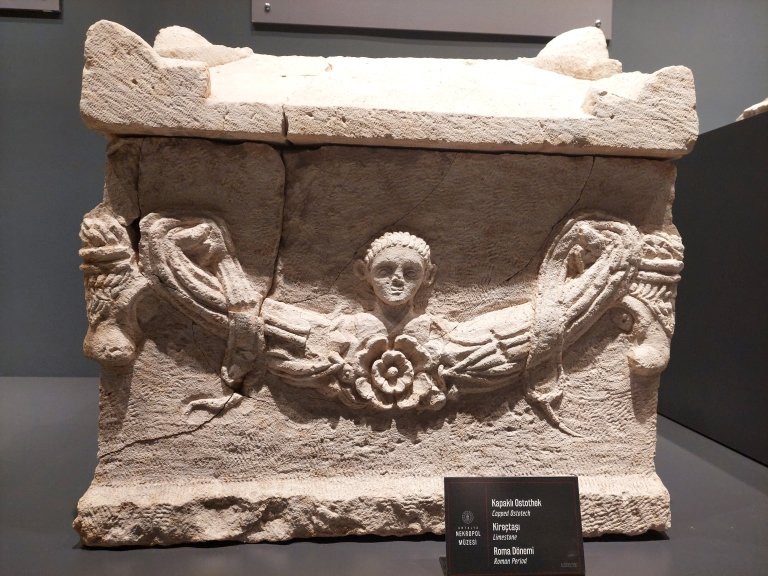
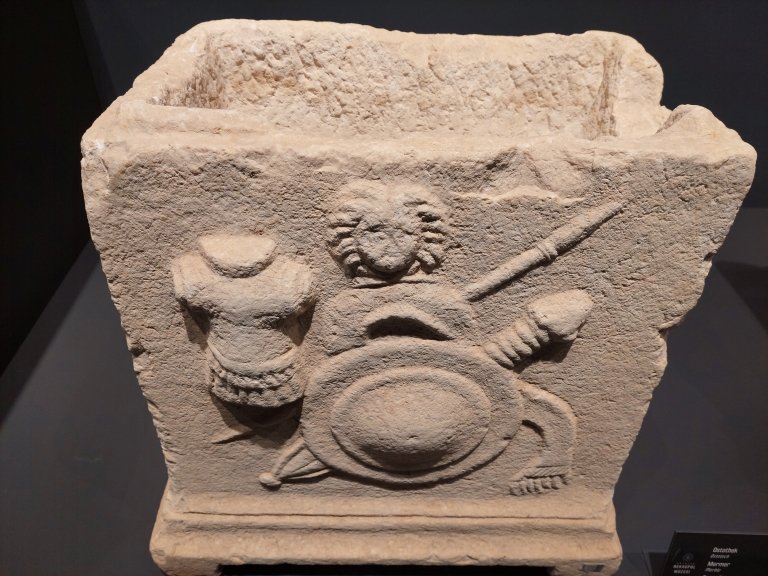
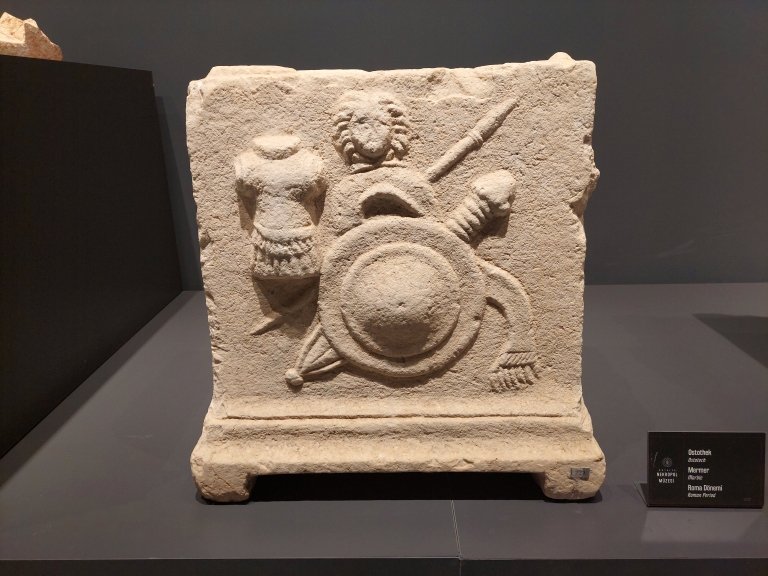
A few Aediculae are on display. These are small, ornate structures on top of graves. These structures might have been dedicated to the memory of the deceased or the peace of the soul.
Ayrıca az sayıda Aedicula sergileniyor. Bunlar mezarın üzerindeki küçük ve süslü yapılar. Bu yapılar genellikle mezarın anısına veya ruhun huzuruna adanmış olabilir.

Some sarcophagi feature bird figures. Birds generally symbolize freedom, the journey of the soul and things related to spirituality.
Bazı lahitlerde kuş figürlerine rastlanmakta. Kuşlar genelde özgürlüğü, ruhun yolculuğunu ve dinle ilgili şeyleri simgeler.

Tombstones and steles in the museum dating back to the 19th and 20th centuries are also on display.
Müzede 19-20. yüzyıla ait mezar taşları, steller ve benzer buluntular da sergilenmekte.


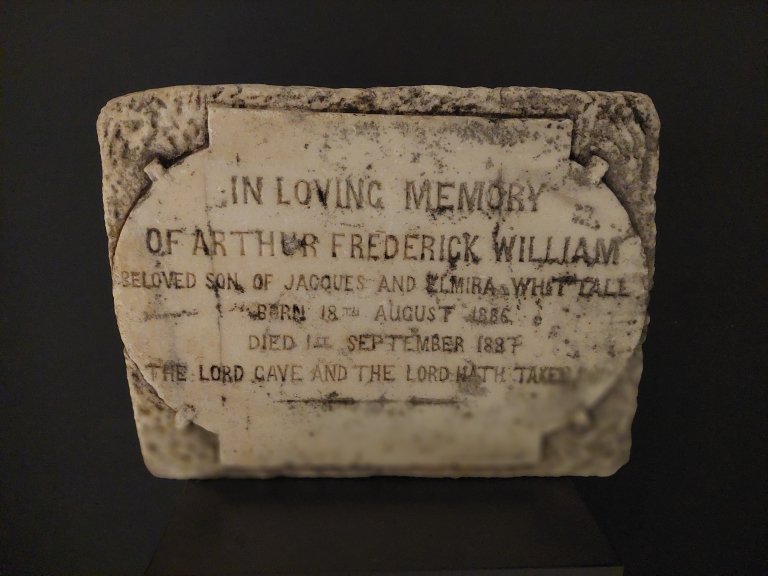
Earthenware pots found in the graves are exhibited in one of the halls. These are significant pieces reflecting different time periods and cultures, shedding light on the lifestyles and cultures of past civilizations. They offer important clues about the lives of people in ancient times.
Mezarlarda bulunan toprak kaplar da salonlardan birinde yerini almış. Bunlar farklı zaman dilimlerinden gelen ve geçmiş medeniyetlerin yaşam tarzlarını ve kültürlerini yansıtan önemli parçalar. Antik dönem insanlarının yaşamlarına dair önemli ipuçları sunmaktalar.


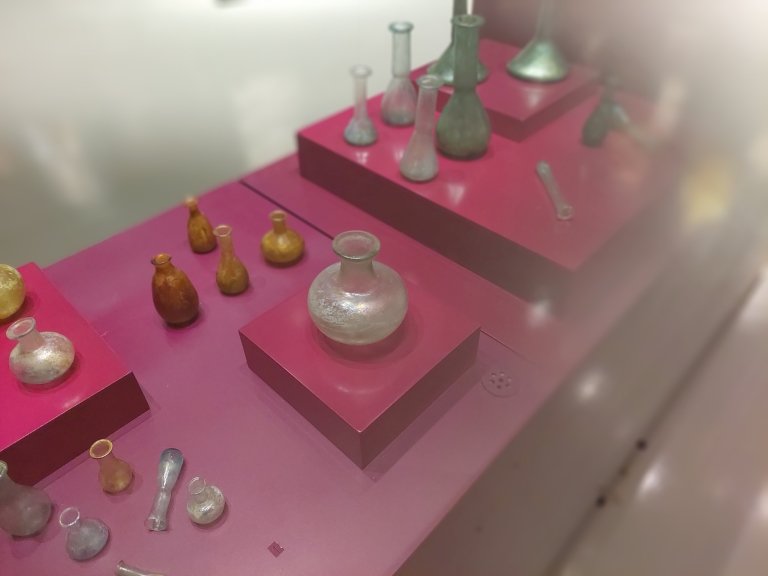
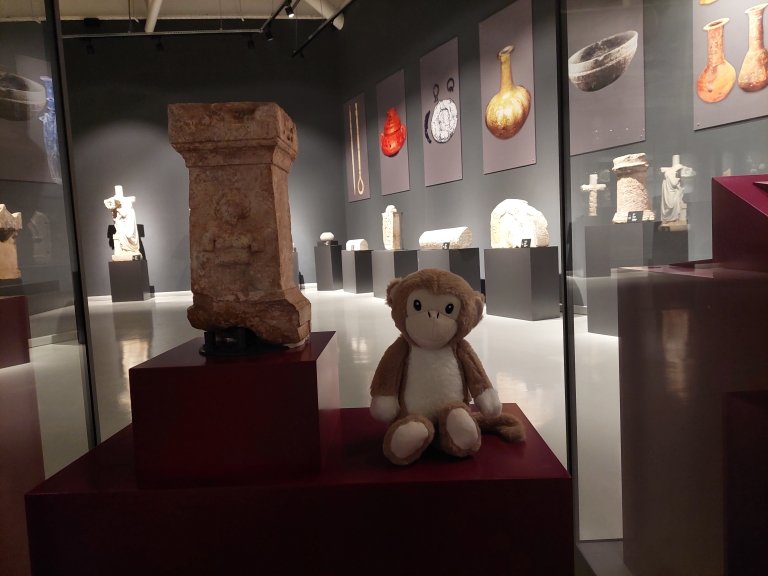
Gift Shop Market - Hediyelik Eşyalar Çarşısı
The museum is very close to the center of Antalya. After about a 15 minute walk from the museum, you reach the city center. Along this walking route, there are beautiful markets displaying various souvenirs and handmade products. These markets, showcasing local products, offer tourists the opportunity to shop and experience the local way of life more intimately.
Müze Antalya'nın merkezinde çok yakın. Çıktıktan sonra 15 dakika kadar yürüdükten sonra merkeze ulaşılıyor. Bu yürüyüş yolunun üzerinde çeşitli hediyelik eşyaların ve el emeği ürünlerin sergilendiği güzel çarşılar bulunuyor. Yöresel ürünleriyle dikkat çeken bu çarşılar turistlere alışveriş yapma ve yerel yaşam tarzını daha yakından deneyimleme imkanı sunuyor.
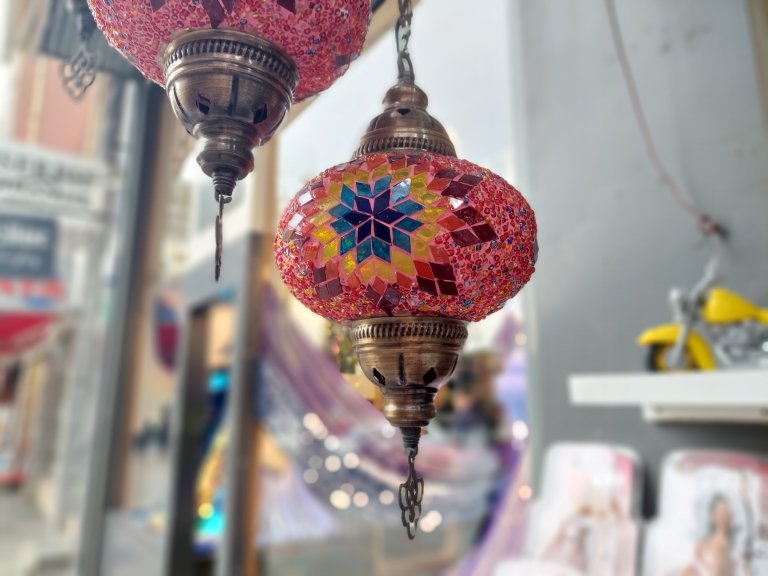

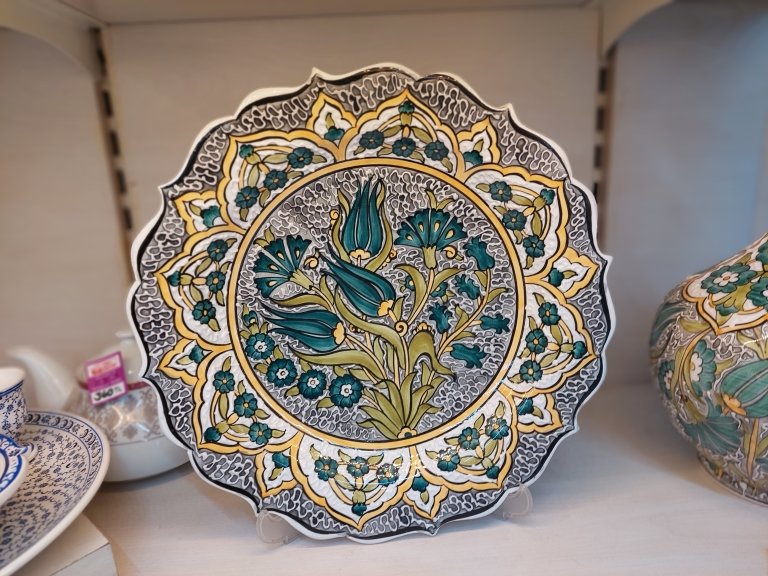




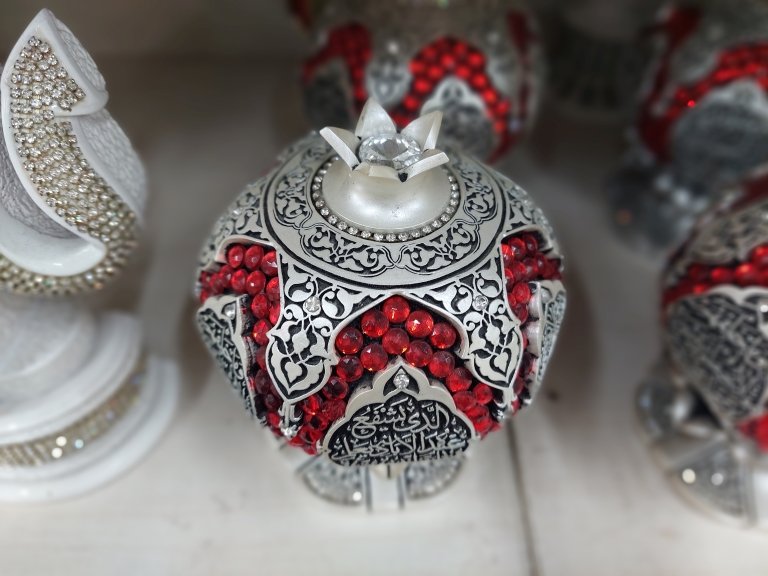
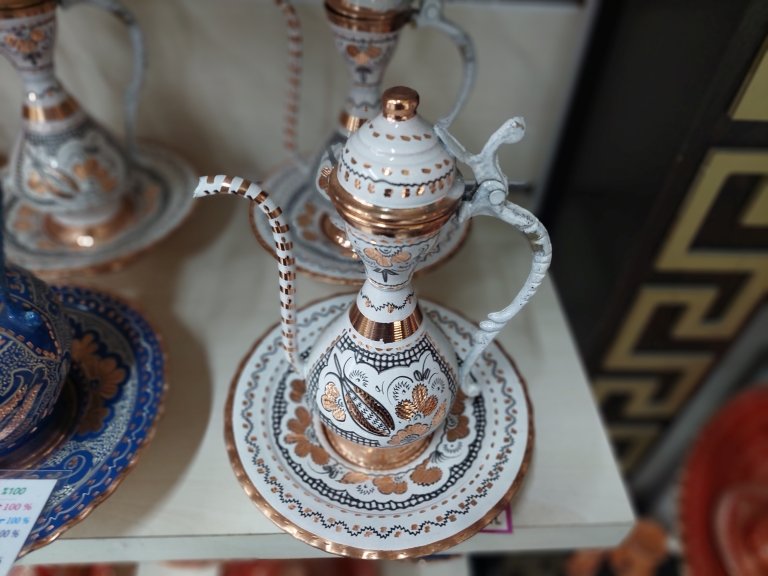
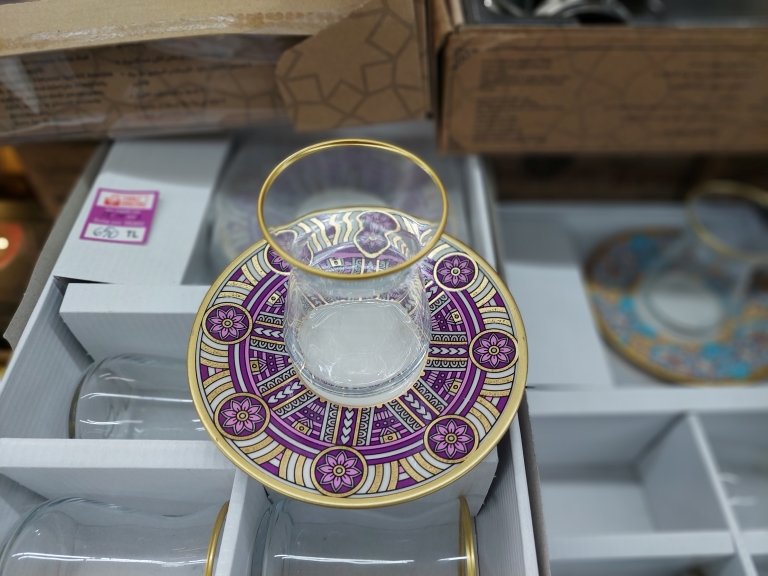


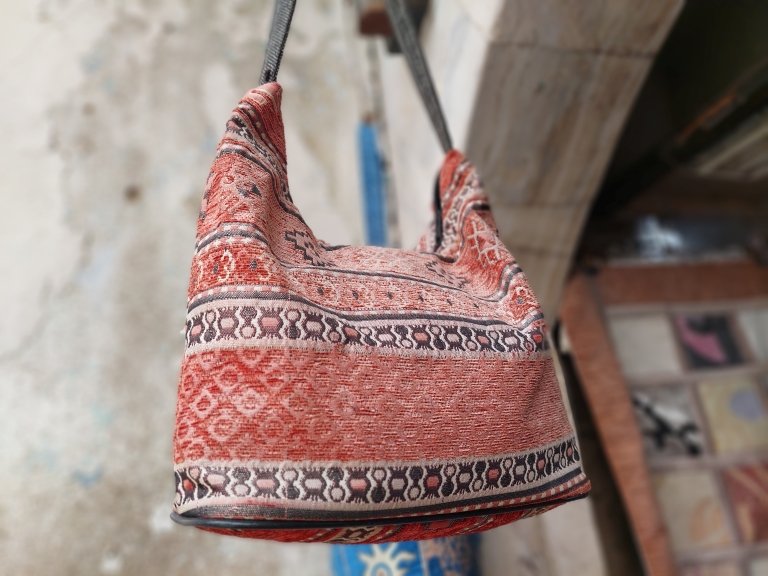
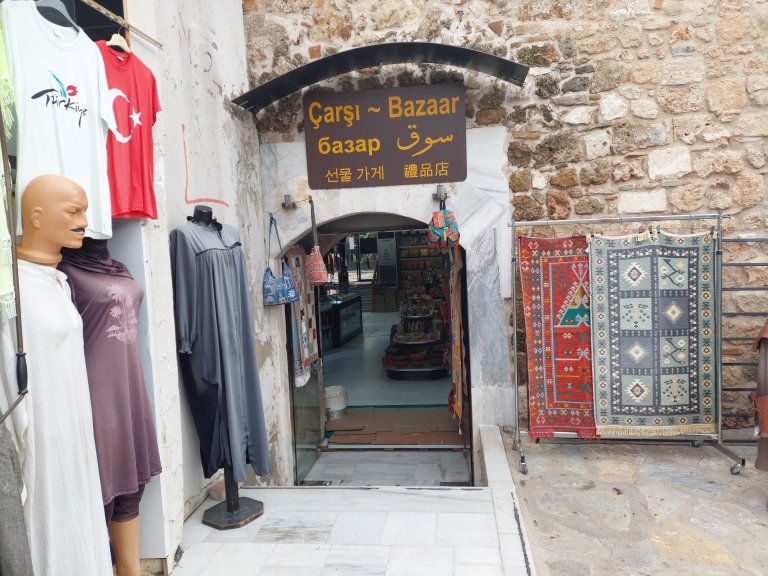
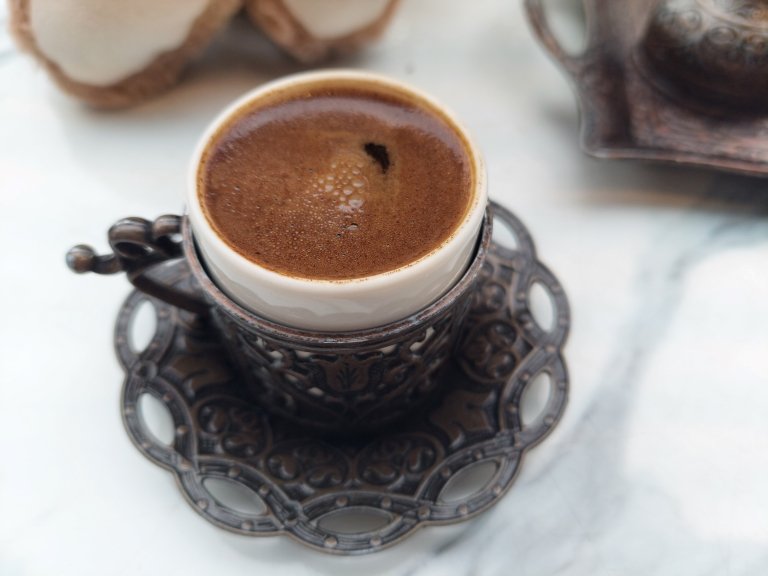
Turkish Coffee Cooked in Sand - Kumda Pişirilen Türk Kahvesi
After leaving the market, I stopped by a café where Turkish coffee was prepared using the traditional method in sand. The surroundings were magnificent, complementing the brewing of this Turkish coffee on the sand. It was a perfect opportunity to relax a bit.
Çarşıdan çıktıktan sonra kahve molası verme zamanının geldiğini düşünerek kumda Türk kahvesi pişiren bu kahveciye uğradım. Kum üzerinde demlenen ve geleneksel yöntemle hazırlanan bu Türk kahvesinin yanı sıra, etrafı saran manzara da muhteşemdi. Biraz dinlenmek için mükemmel bir fırsat oldu.

Statue of Attalos - Attalos Heykeli
Here is the statue of the founder of Antalya, 2nd Attalos, that I mentioned in the necropolis museum section. According to a well-known legend among people of all ages in Antalya, the king ordered his soldiers to find him paradise on Earth and after searching everywhere, they discovered Antalya. The king was pleased and laid the foundations of today's Antalya city.
İşte nekropol müzesi kısmında bahsettiğim Antalya'nın kurucusu 2. Attalos'un heykeli. Antalya'da küçükten büyüğe herkesin bildiği efsaneye göre, kral askerlerine bana dünyadaki cenneti bulun diye emretmiş ve her tarafı arayıp tarayan askerler Antalya'yı bulmuşlar. Kral da burayı beğenince bugünkü Antalya şehrinin temelleri atılmış.

Can't Do Without Cats - Kedisiz Olmaz
Cats and dogs in Antalya are dearly loved. Due to the abundance of cats in the area, there are even signs cautioning people to be careful.
Antalya'nın kedileri ve köpekleri çok seviliyor. Bu civarda çok fazla kedi olduğundan dikkatli olunması için kedi işaretleri bile yer almakta.
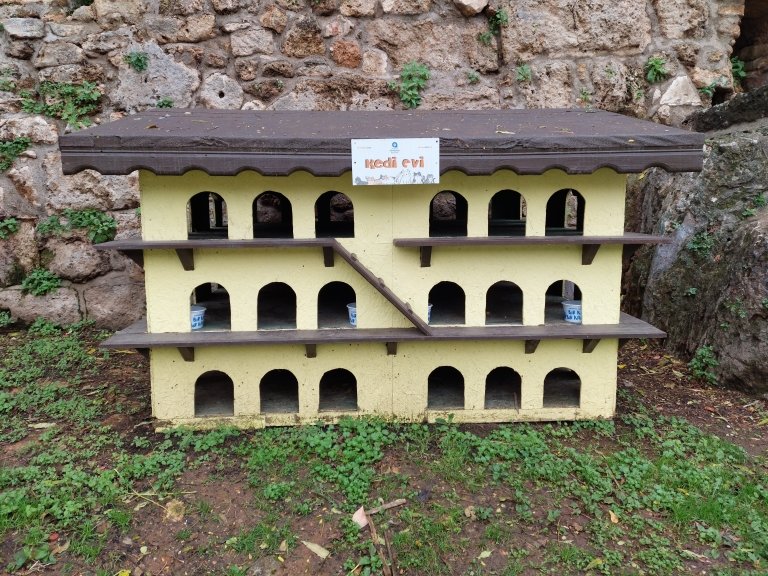
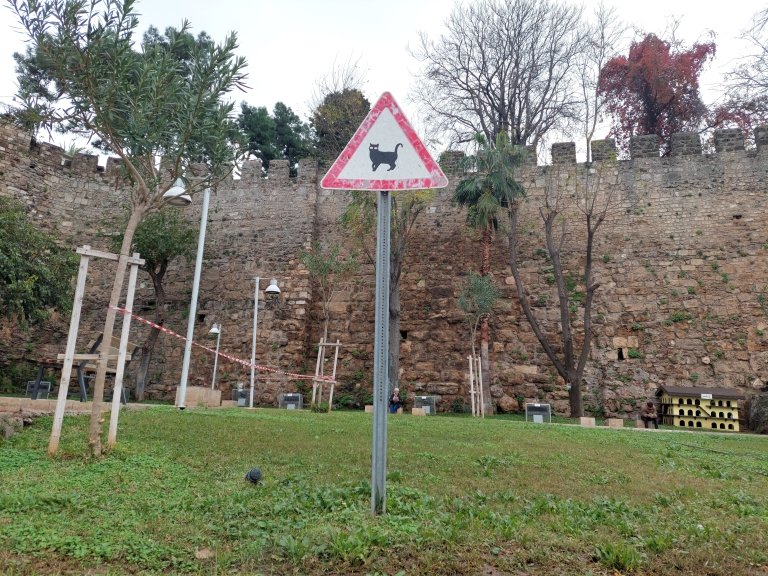
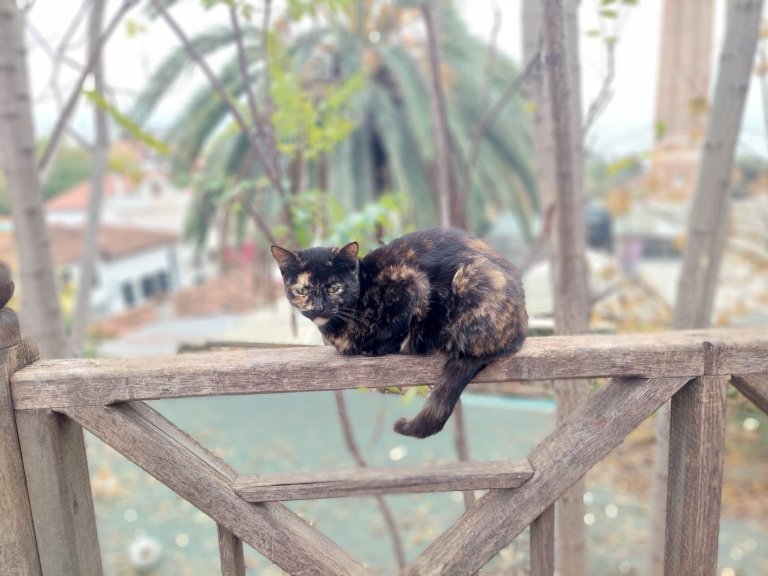

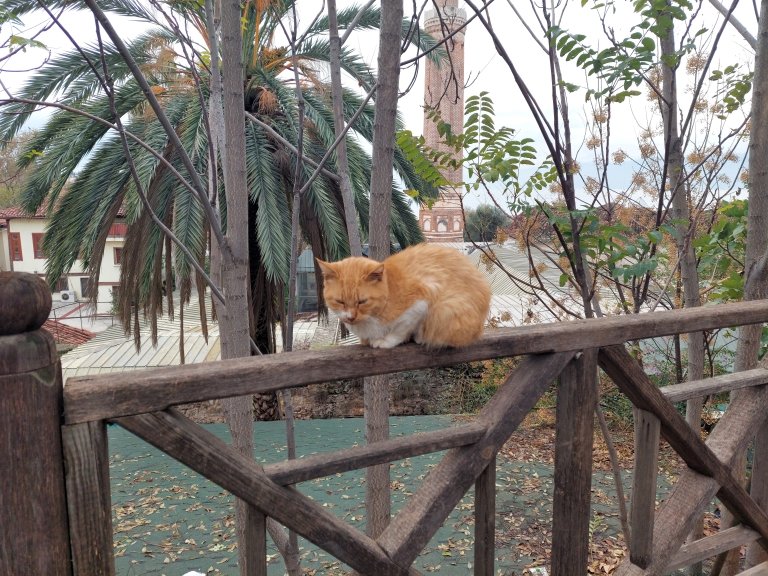



Kaleiçi (Old city) and Marina - Kaleiçi ve Yat Limanı
Kaleiçi was bustling today. It's the famous Tophane tea garden. Located right in the heart of the city, the view is stunning. There's an elevator nearby that descends to the marina. Recently a film called "Operation Fortune" was shot here. I wasn't in Antalya during the filming, but I didn't miss the chance to watch it in the cinema. The film starred legendary actors like Jason Statham, Hugh Grant, along with the beloved Turkish actor Kaan Urgancıoğlu.
Kaleiçi bugün kalabalıktı. Burası ünlü Tophane çay bahçesi. Şehrin tam göbeğinde yer almakta, manzarası çok güzel. Hemen yan tarafında yat limanına inilen bir asansör bulunuyor. Burada yakın zamanda Servet operasyonu adlı film çekildi. Film çekildiğinde Antalya'da değildim ama sinemada izleme fırsatını kaçırmadım. Filmde Jason Statham, Hugh Grant gibi efsane oyuncuların yanı sıra Kaan Urgancıoğlu adlı sevilen Türk oyuncu da rol alıyor.
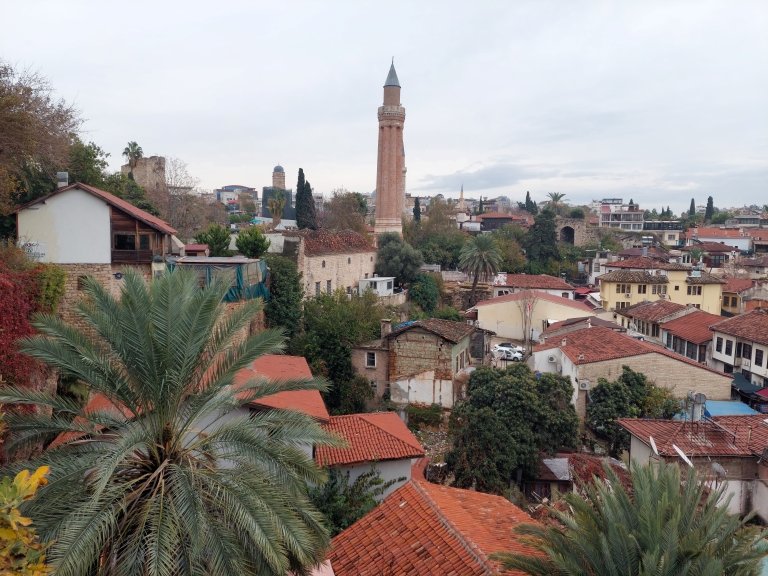

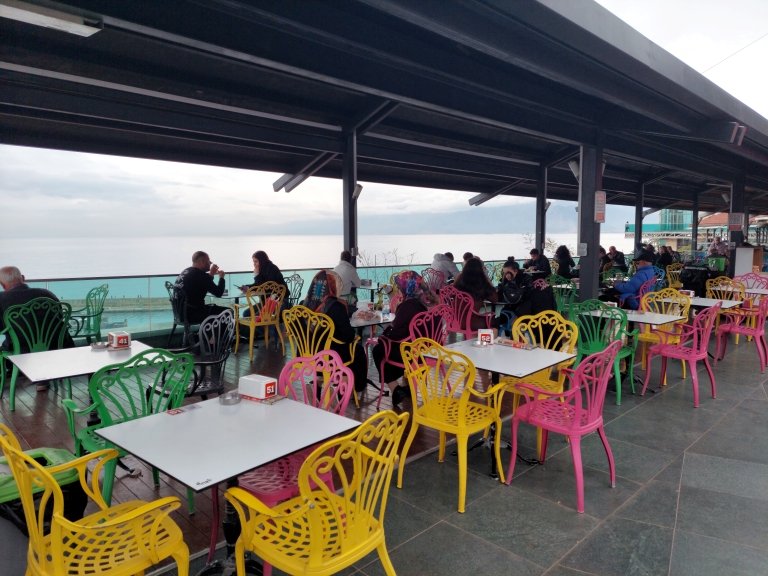

Boat Tour - Yat Turu
After taking the elevator down to the marina, I purchased a ticket for a two-hour boat tour. Unfortunately the tour didn't happen. I guess because rain was expected, nobody wanted to go on a long tour. However there were enough people for a short tour. I was hoping for a pirate ship, but they arranged a simpler boat named Barış 1.
Asansörle yat limanına indikten sonra iki saatlik yat turu için bilet aldım. Maalesef tur gerçekleşmedi. Sanırım yağmur beklentisi olduğundan kimse uzun tura çıkmak istemiyordu. Ama kısa tur için yeterli sayı toplanmıştı. Korsanlı tekne denk gelir diye umuyordum ama Barış 1 adlı daha sade bir tekne ayarlanmıştı.
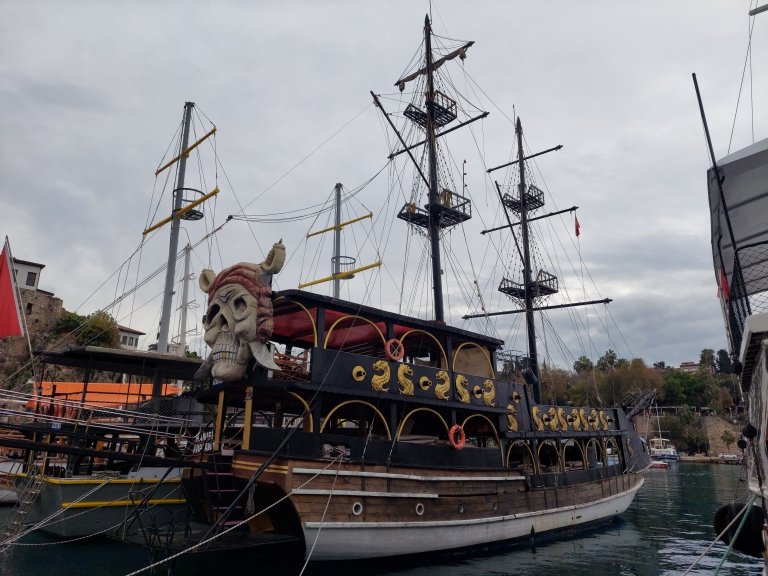
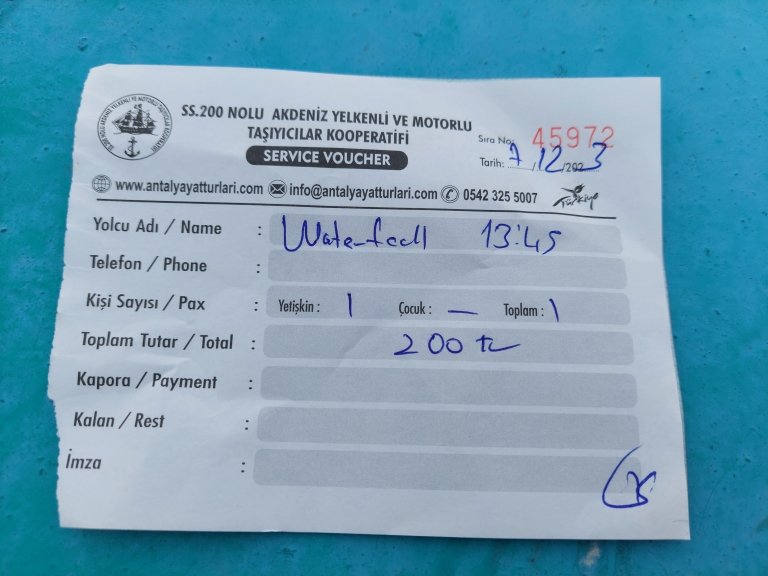



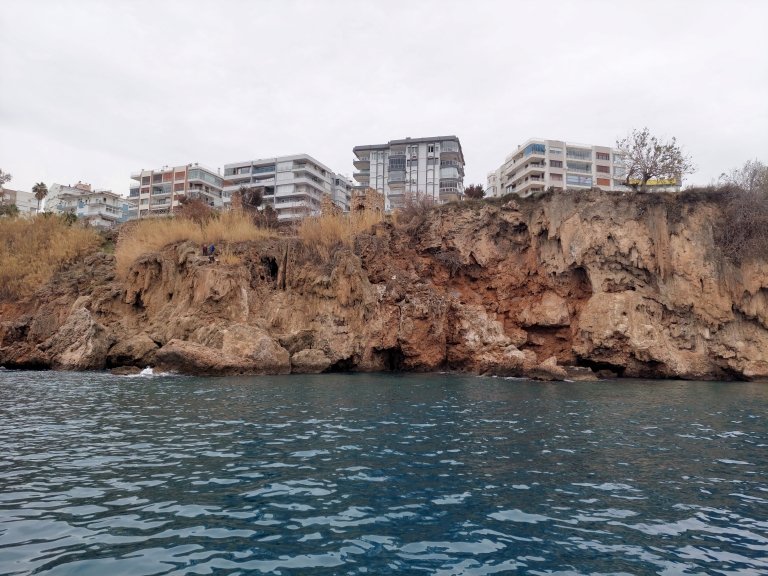
We watched the caves, waterfall, and hotels along the coastline. I thought it would be more fun if it rained, but the expected rain never came :)
Sahildeki mağaraları, şelaleyi ve otelleri izledik. Yağmur yağarsa daha eğlenceli olacağını düşünmüştüm ama beklenen yağmur bir türlü yağmadı :)


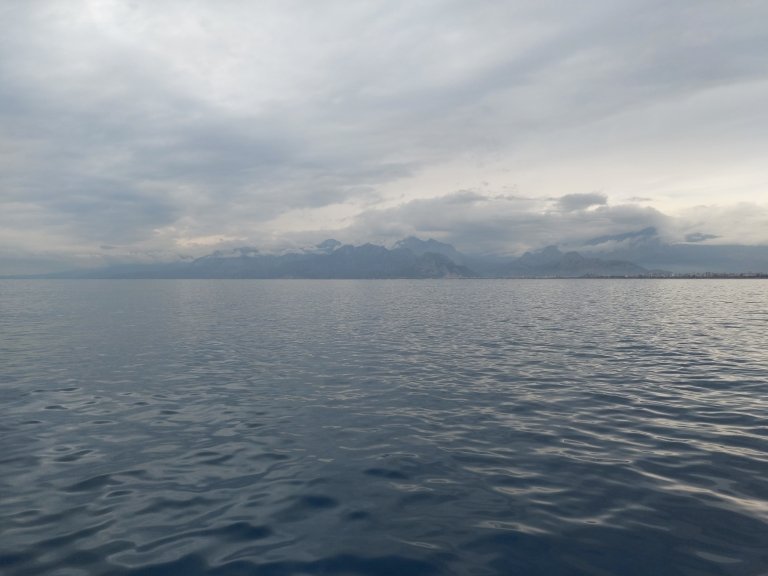
Posing for Honey wasn't too difficult. I thought it suited the boat quite well.
Bal için poz vermek çok zor olmadı. Bence tekneyle çok uyumluydu.

But towards the end, Honey might have been a bit tired.
Ama sonlara doğru biraz yorgun düşmüş olabilir.





Antalya Street Foods - Antalya Sokak Yemekleri
On the way back home we stumbled upon an array of diverse street foods. It was a street food festival filled with delights like doner kebabs, chestnuts, simit and corn roasted over coals.
Eve dönüş yolunda sokak lezzetlerinin zengin çeşitliliği bizi karşıladı. Döner, kestane, simit ve közde pişmiş mısır gibi yiyeceklerle dolu bir sokak yemeği festivali yaşadık.
